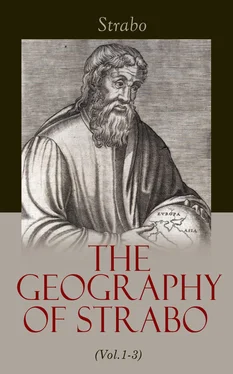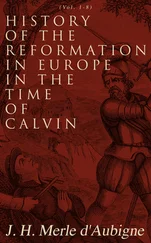Strabo - The Geography of Strabo (Vol.1-3)
Здесь есть возможность читать онлайн «Strabo - The Geography of Strabo (Vol.1-3)» — ознакомительный отрывок электронной книги совершенно бесплатно, а после прочтения отрывка купить полную версию. В некоторых случаях можно слушать аудио, скачать через торрент в формате fb2 и присутствует краткое содержание. Жанр: unrecognised, на английском языке. Описание произведения, (предисловие) а так же отзывы посетителей доступны на портале библиотеки ЛибКат.
- Название:The Geography of Strabo (Vol.1-3)
- Автор:
- Жанр:
- Год:неизвестен
- ISBN:нет данных
- Рейтинг книги:3 / 5. Голосов: 1
-
Избранное:Добавить в избранное
- Отзывы:
-
Ваша оценка:
- 60
- 1
- 2
- 3
- 4
- 5
The Geography of Strabo (Vol.1-3): краткое содержание, описание и аннотация
Предлагаем к чтению аннотацию, описание, краткое содержание или предисловие (зависит от того, что написал сам автор книги «The Geography of Strabo (Vol.1-3)»). Если вы не нашли необходимую информацию о книге — напишите в комментариях, мы постараемся отыскать её.
The Geography of Strabo (Vol.1-3) — читать онлайн ознакомительный отрывок
Ниже представлен текст книги, разбитый по страницам. Система сохранения места последней прочитанной страницы, позволяет с удобством читать онлайн бесплатно книгу «The Geography of Strabo (Vol.1-3)», без необходимости каждый раз заново искать на чём Вы остановились. Поставьте закладку, и сможете в любой момент перейти на страницу, на которой закончили чтение.
Интервал:
Закладка:
2. He then declares that the ancient geographical chart wants revision; that in it the eastern portion of the Taurus is made to run too far north, India itself being also too much drawn in the same direction. One proof which he offers in support of this is, that the most southern extremities of India are under the same latitude as Meroe, as attested by many, both from astronomical observations and the temperature of the climate. From thence to the most northerly point by the mountains of the Caucasus, 478there are 15,000 stadia, according to Patrocles, a writer whom we are bound to believe, both on account of his worth, and the vast amount of his geographical attainments. Now since the distance from Meroe to the parallel of Athens is nearly the same, the most northerly points of India next to the Caucasian mountains ought to be under the same degree of latitude.
3. But there is another method (says Eratosthenes) of proving this. The distance from the Gulf of Issus to the Euxine, proceeding in a northerly direction towards Amisus 479and Sinope, 480is about 3000 stadia, which is as much as the supposed extent of the mountains [of the Taurus]. 481The traveller who directs his course from Amisus due east, 482arrives first at Colchis, then at the high lands by the Hyrcanian Sea, 483afterwards at the road leading to Bactra, 484and beyond to the Scythians; having the mountains always on the right. The same line drawn through Amisus westward, crosses the Propontis and Hellespont. From Meroe to the Hellespont there are not more than 18,000 stadia. 485The distance is just the same from the southern extremity of India to the land of Bactria, if we add to the 15,000 stadia of that country the 3000 which its mountains occupy in breadth.
4. Hipparchus tries to invalidate this view of Eratosthenes, by sneering at the proofs on which it rests. Patrocles, he says, merits little credit, being contradicted by the two writers Deimachus and Megasthenes, who say that the distance 486taken from the southern ocean, is in some places 20,000, in others 30,000 stadia; that in this assertion they are supported by the ancient charts, and he considers it absurd to require us to put implicit faith in Patrocles alone, when there is so much testimony against him; or that the ancient charts should be corrected; but rather that they should be left as they are until we have something more certain on the subject.
5. This argument, I think, is in many instances unfounded. Eratosthenes availed himself of the statements of many writers, although Hipparchus alleges he was solely led by Patrocles. Who then are the authors of the statement that the southern extremity of India is under the same parallel as Meroe; and who are they who estimate 487the distance from Meroe to the parallel passing through Athens? Or who, again, were those who asserted that the whole breadth occupied by the mountains 488was equal to the distance from Cilicia to Amisus? Or who made known that, travelling from Amisus, the course lay in a straight line due east through Colchis, the [sea of] Hyrcania, so on to Bactria, and beyond this to the eastern ocean, 489the mountains being always on the right hand; and that this same line carried west in a straight line, traverses the Propontis and the Hellespont? These things Eratosthenes advances on the testimony of men who had been on the spot, and from the study of those numerous memoirs which he had for reference in that noble library 490which Hipparchus himself acknowledges to be gigantic.
6. Besides, the credibility of Patrocles can be proved by a variety of evidence—the princes 491who confided to him so important trusts—the authors who follow his statements—and those, too, who criticise them, whose names Hipparchus has recorded. Since whenever these are refuted, the credit of Patrocles is by so much advanced. Nor does Patrocles appear to state any thing improbable when he says that the army of Alexander took but a very hasty view of every thing [in India], but Alexander himself a more exact one, causing the whole country to be described by men well acquainted with it. Which description he says was afterwards put into his hands by Xenocles the treasurer.
7. Again, in the second volume of his Commentaries, Hipparchus accuses Eratosthenes of himself throwing discredit on the statement of Patrocles, on account of his differing with Megasthenes, as to the length of India on its northern side; 492Megasthenes stating the length at 16,000 stadia, and Patrocles at 1000 less. Being biased by a certain Itinerary, Eratosthenes was led to reject them both on account of this discrepancy, and to follow the Itinerary. If then merely the difference of 1000 stadia is sufficient to cause the authority of Patrocles to be rejected, how much more should this be the case when we find a difference of 8000 stadia between his statement and that of two writers who agree perfectly in theirs, that the breadth of India is 20,000 stadia, while he gives only 12,000!
8. We reply, that [Eratosthenes] did not object [to the statement of Patrocles] merely because it differed [from that of Megasthenes], but because the statement of this latter as to the stadia was confirmed by the Itinerary, an authority of no mean importance. There is nothing wonderful in this, that though a certain statement may be credible, another may be more credible; and that while in some instances we follow the former, in others we may dissent from it on finding a more trustworthy guide. It is ridiculous to say that the greater the difference of one writer from others, the less he should be trusted. On the contrary, such a rule would be more applicable in regard to small differences; for in little particulars the ordinary observer and the man of great ability are equally liable to err. On the other hand, in great matters, the ordinary run of men are more like to be deceived than the man of superior talent, to whom consequently in such cases greater deference is paid.
9. Generally speaking, the men who hitherto have written on the affairs of India, were a set of liars. Deimachus holds the first place in the list, Megasthenes comes next, while Onesicritus and Nearchus, with others of the same class, manage to stammer out a few words [of truth]. Of this we became the more convinced whilst writing the history of Alexander. No faith whatever can be placed in Deimachus and Megasthenes. They coined the fables concerning men with ears large enough to sleep in, men without any mouths, without noses, with only one eye, with spider-legs, and with fingers bent backward. They renewed Homer’s fable concerning the battles of the Cranes and Pygmies, and asserted the latter to be three spans high. They told of ants digging for gold, of Pans with wedge-shaped heads, of serpents swallowing down oxen and stags, horns and all; meantime, as Eratosthenes has observed, reciprocally accusing each other of falsehood. Both of these men were sent ambassadors to Palimbothra, 493—Megasthenes to Sandrocottus, Deimachus to Allitrochades his son; and such are the notes of their residence abroad, which, I know not why, they thought fit to leave. Patrocles certainly does not resemble them; nor do any other of the authorities consulted by Eratosthenes contain such absurdities.
10. 494If the meridian of Rhodes and Byzantium has been rightly determined to be the same, then that of Cilicia and Amisus has likewise been rightly determined; many observations having proved that the lines are parallel, and that they never impinge on each other.
11. In like manner, that the voyage from Amisus to Colchis, and the route to the Caspian, and thence on to Bactra, are both due east, is proved by the winds, the seasons, the fruits, and even the sun-risings. Frequently evidence such as this, and general agreement, are more to be relied on than the measurement taken by means of instruments. Hipparchus himself was not wholly indebted to instruments and geometrical calculations for his statement that the Pillars and Cilicia lie in a direct line due east. For that part of it included between the Pillars and the Strait of Sicily he rests entirely on the assertion of sailors. It is therefore incorrect to say that, because we cannot exactly determine the duration of the longest and shortest days, nor the degree of shadow of the gnomon throughout the mountainous region between Cilicia and India, that therefore we are unable to decide whether the line traced obliquely on the ancient charts should or should not be parallel, and consequently must leave it unreformed, keeping it oblique as the ancient charts have it. For in the first place, not to determine any thing is to leave it undetermined; and to leave a thing undetermined, is neither to take one view of the matter nor the other: but to agree to leave it as the ancients have, that is to take a view of the case. It would have been more consistent with his reasoning, if he had told us to leave Geography alone altogether, since we are similarly unable to determine the position of the Alps, the Pyrenees, and the mountains of Thrace, 495Illyria, 496and Germany. Wherefore should we give more credit to the ancient writers than to the modern, when we call to mind the numerous errors of their charts which have been pointed out by Eratosthenes, and which Hipparchus has not attempted to defend.
Читать дальшеИнтервал:
Закладка:
Похожие книги на «The Geography of Strabo (Vol.1-3)»
Представляем Вашему вниманию похожие книги на «The Geography of Strabo (Vol.1-3)» списком для выбора. Мы отобрали схожую по названию и смыслу литературу в надежде предоставить читателям больше вариантов отыскать новые, интересные, ещё непрочитанные произведения.
Обсуждение, отзывы о книге «The Geography of Strabo (Vol.1-3)» и просто собственные мнения читателей. Оставьте ваши комментарии, напишите, что Вы думаете о произведении, его смысле или главных героях. Укажите что конкретно понравилось, а что нет, и почему Вы так считаете.












![Anne Blunt - A Pilgrimage to Nejd, the Cradle of the Arab Race. Vol. 2 [of 2]](/books/750183/anne-blunt-a-pilgrimage-to-nejd-the-cradle-of-the-thumb.webp)